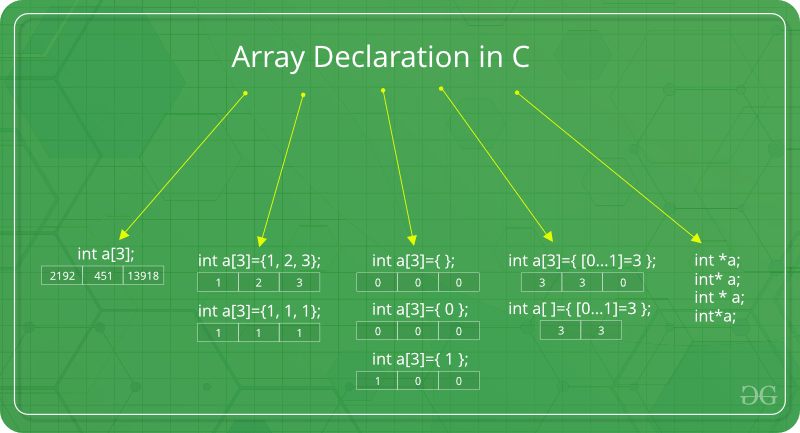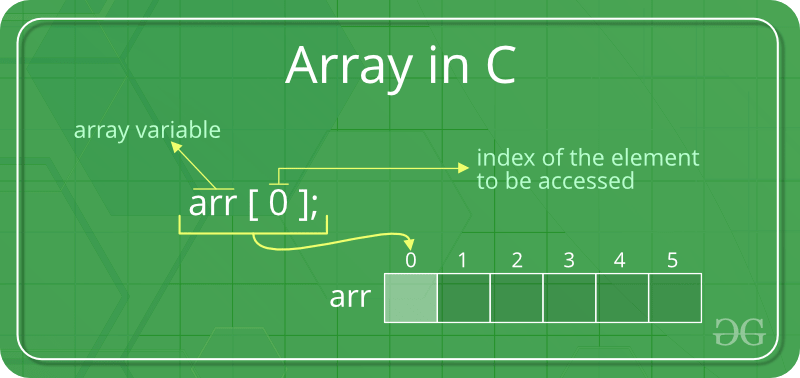How to Read an Int Into an Array in C
An array in C/C++ or be it in whatever programming linguistic communication is a drove of similar data items stored at contiguous memory locations and elements can exist accessed randomly using indices of an array. They can exist used to shop collection of primitive data types such as int, float, double, char, etc of any particular type. To add to it, an array in C/C++ can store derived data types such as the structures, pointers etc. Given below is the pic representation of an assortment.

Why do nosotros demand arrays?
We can use normal variables (v1, v2, v3, ..) when nosotros take a minor number of objects, but if we want to store a large number of instances, it becomes difficult to manage them with normal variables. The idea of an array is to represent many instances in one variable.
Array declaration in C/C++:

Notation: In higher up prototype int a[3]={[0…one]=3}; this kind of declaration has been obsolete since GCC 2.v
There are various ways in which nosotros can declare an array. It can be washed past specifying its type and size, by initializing it or both.
Array declaration by specifying size
C
int arr1[10];
int due north = ten;
int arr2[n];
Array declaration by initializing elements
C
int arr[] = { 10, xx, xxx, 40 }
Assortment annunciation by specifying size and initializing elements
C
int arr[six] = { 10, 20, 30, forty }
Advantages of an Array in C/C++:
- Random access of elements using assortment index.
- Employ of fewer line of code equally it creates a single array of multiple elements.
- Easy access to all the elements.
- Traversal through the array becomes easy using a single loop.
- Sorting becomes piece of cake as information technology can be accomplished by writing fewer line of code.
Disadvantages of an Array in C/C++:
- Allows a stock-still number of elements to exist entered which is decided at the time of proclamation. Different a linked list, an array in C is non dynamic.
- Insertion and deletion of elements can be plush since the elements are needed to be managed in accordance with the new memory resource allotment.
Facts near Array in C/C++:
- Accessing Array Elements:
Assortment elements are accessed by using an integer alphabetize. Array index starts with 0 and goes till size of array minus 1. - Name of the array is also a pointer to the first chemical element of assortment.

Example:
C
#include <stdio.h>
int main()
{
int arr[5];
arr[0] = v;
arr[2] = -x;
arr[3 / 2] = two;
arr[3] = arr[0];
printf ( "%d %d %d %d" , arr[0],
arr[ane], arr[two], arr[iii]);
return 0;
}
C++
#include <iostream>
using namespace std;
int main()
{
int arr[5];
arr[0] = 5;
arr[2] = -10;
arr[three / 2] = two;
arr[three] = arr[0];
cout << arr[0] << " " << arr[1] << " " << arr[2] << " "
<< arr[3];
return 0;
}
Output
5 2 -10 5
No Index Out of bound Checking:
At that place is no index out of premises checking in C/C++, for example, the following program compiles fine but may produce unexpected output when run.
C
#include <stdio.h>
int main()
{
int arr[ii];
printf ( "%d " , arr[three]);
printf ( "%d " , arr[-2]);
return 0;
}
C++
#include <iostream>
using namespace std;
int main()
{
int arr[two];
cout << arr[three] << " " ;
cout << arr[-2] << " " ;
return 0;
}
In C, information technology is not a compiler mistake to initialize an assortment with more elements than the specified size. For example, the beneath program compiles fine and shows just Alarm.
C
#include <stdio.h>
int primary()
{
int arr[ii] = { 10, 20, xxx, twoscore, l };
return 0;
}
Warnings:
prog.c: In function 'main': prog.c:7:25: warning: excess elements in array initializer int arr[2] = { 10, twenty, xxx, 40, 50 }; ^ prog.c:7:25: note: (almost initialization for 'arr') prog.c:7:29: alarm: excess elements in array initializer int arr[2] = { 10, xx, thirty, 40, 50 }; ^ prog.c:7:29: note: (almost initialization for 'arr') prog.c:7:33: alarm: backlog elements in assortment initializer int arr[2] = { 10, twenty, 30, 40, l }; ^ prog.c:seven:33: note: (well-nigh initialization for 'arr') - Note: The plan won't compile in C++. If we save the in a higher place program as a .cpp, the program generates compiler error "fault: too many initializers for 'int [two]'".
The elements are stored at contiguous memory locations
Example:
C
#include <stdio.h>
int primary()
{
int arr[5], i;
printf ( "Size of integer in this compiler is %lu\n" ,
sizeof ( int ));
for (i = 0; i < v; i++)
printf ( "Address arr[%d] is %p\n" , i, &arr[i]);
return 0;
}
C++
#include <iostream>
using namespace std;
int main()
{
int arr[5], i;
cout << "Size of integer in this compiler is "
<< sizeof ( int ) << "\north" ;
for (i = 0; i < five; i++)
cout << "Accost arr[" << i << "] is " << &arr[i]
<< "\n" ;
return 0;
}
Output
Size of integer in this compiler is 4 Accost arr[0] is 0x7ffe75c32210 Address arr[i] is 0x7ffe75c32214 Accost arr[2] is 0x7ffe75c32218 Accost arr[3] is 0x7ffe75c3221c Address arr[four] is 0x7ffe75c32220
Another way to traverse the assortment
C++
#include<bits/stdc++.h>
using namespace std;
int main()
{
int arr[6]={11,12,thirteen,14,15,sixteen};
for ( int i=0;i<half-dozen;i++)
cout<<arr[i]<< " " ;
cout<<endl;
cout<< "Past Other Method:" <<endl;
for ( int i=0;i<6;i++)
cout<<i[arr]<< " " ;
cout<<endl;
return 0;
}
Output
11 12 13 14 15 16 By Other Method: 11 12 13 fourteen fifteen 16
Array vs Pointers
Arrays and pointers are two dissimilar things (we can bank check by applying sizeof). The confusion happens considering array name indicates the accost of first element and arrays are e'er passed as pointers (fifty-fifty if we use square subclass). Please meet Deviation between arrow and array in C? for more details.
What is vector in C++?
A vector in C++ is a form in STL that represents an array. The advantages of vector over normal arrays are,
- Nosotros do not need pass size as an extra parameter when we declare a vector i.e, Vectors support dynamic sizes (we practise not have to initially specify size of a vector). Nosotros tin can also resize a vector.
- Vectors have many in-built functions like, removing an element, etc.
To know more almost functionalities provided by vector, please refer vector in C++ for more details.
Related Articles:
Please write comments if yous find anything incorrect, or you desire to share more information about the topic discussed to a higher place.
Source: https://www.geeksforgeeks.org/arrays-in-c-cpp/
0 Response to "How to Read an Int Into an Array in C"
Post a Comment